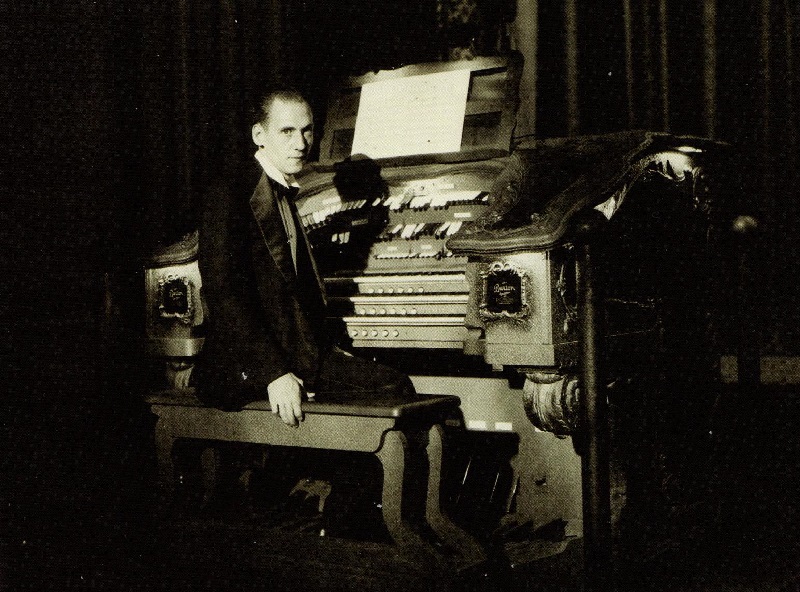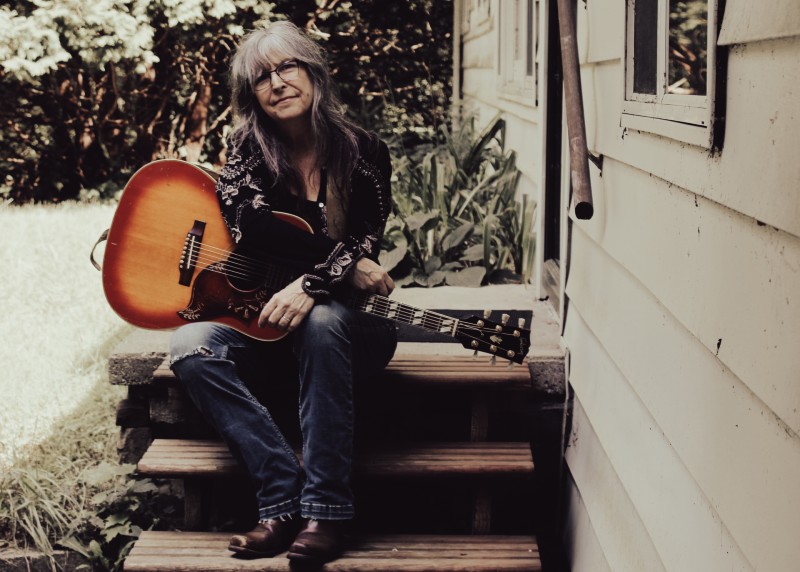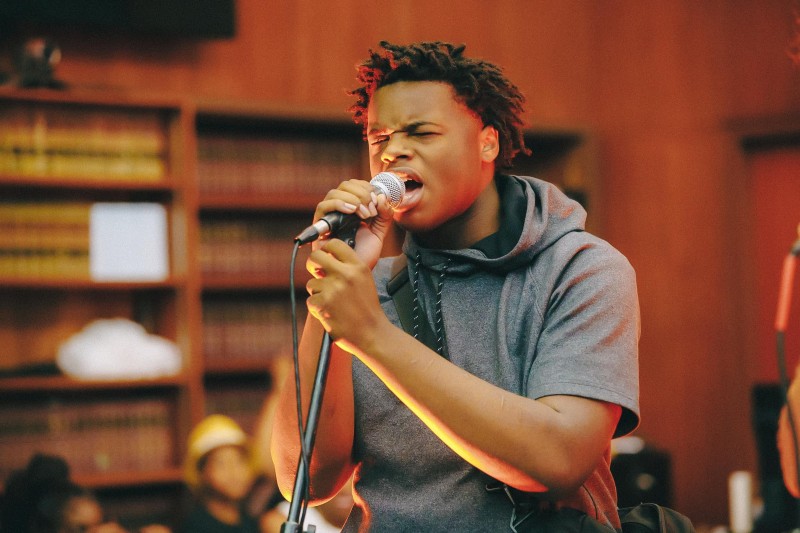10 Years After: Acoustic Routes Celebrates Decade of Concerts, Hosts Benefit Show with Rosanne Cash

In the late ‘80s, Jim Cain didn’t expect a Midwest tour with his friends’ punk band would lead to a love of acoustic music.
As the band’s roadie and road manager in college, he heard artists like Ralph Stanley, Lyle Lovett, and Bill Monroe while traveling in a crammed Oldsmobile Cutlass with his Michigan State University pals and became intrigued.
“My tastes growing up were more The Beatles, The Stones, and The Who,” said Cain, now the founder and curator of Saline’s Acoustic Routes concert series, which celebrates its 10th anniversary this month.
“A couple of friends at the same time started exploring more traditional artists like The Louvin Brothers and really went deep into the mix, and that’s just grown over time. I first got exposed to artists like Doc Watson and Mississippi John Hurt when I got inspired to attempt to learn the guitar. All of these things just kinda dovetailed.”
By 2010, Cain’s passion for country, bluegrass, folk, and other traditional acoustic-based music resulted in curating a live show at The Ark with Bonnie Rideout, Duck Baker, Bill Bynum & Co., and Rev. Robert Jones and Sister Bernice Jones.
Office Space: EMU’s “9 to 5: The Musical” Pays Homage to the Comedy Film and Celebrates Female Empowerment

The era of landline phones, typewriters, and carbon copies returns for Eastern Michigan University’s Department of Communication, Media & Theatre Arts production of 9 to 5: The Musical at the Legacy Theatre, March 31 to April 16.
The 9 to 5: The Musical made its Broadway debut in 2009. It’s based on the 1980 comedy film starring Jane Fonda, Lily Tomlin, Dolly Parton, and Dabney Coleman, where the three women, fed up with their terrible boss, plot to take him down.
“A lot of those iconic moments that are in the movie,” such as the women’s revenge fantasies and taking their boss hostage, “we’re making sure that we represent them in the show, sort of how people of a certain age might remember them,” said Ryan Lewis, the production’s musical director and an EMU Department of Communication, Media & Theatre Arts lecturer and musical theater accompanist.
“It’s the vibe and feel of the movie, and the script is really great at paying homage to that. A lot of the characters are expanded and developed more, and I feel like the script is fantastic at doing that. We get to understand their frustration a little bit more than you do in the movie.
“Our set designer Jeromy Hopgood is great with those period pieces and so much of it is in an office in the ‘70s. What does that look like? What does that feel like?
“But then the office has to have a change when the ladies start taking over and start making those big changes. They’re subtle, but they’re significant changes. What are those and how do we make it a brighter place? And a more friendly workplace?”
In 9 to 5: The Musical, Violet Newstand (Leah Saunders), Doralee Rhodes (Brookelyn Hannah), and Judy Bernly (Abby Siegel) struggle with being women in a male-dominated workplace at Consolidated Industries. Newstand can’t get promoted, Rhodes has been objectified, and Bernly has been jilted.
Keys to the Past: Ann Arbor’s Legacy of Theater Organs Creates Timeless Moviegoing Experience for Patrons

It was New Year’s Eve 2011 and we wanted a low-key way to celebrate.
My husband Brian suggested seeing The Artist, a critically acclaimed black-and-white-silent French film, at Ann Arbor’s Michigan Theater that evening.
The theater’s Screening Room featured a couple of showings, and we opted for the 9 pm show. That way, we could see the film and still get home to watch the Times Square ball drop at midnight on Dick Clark’s New Year’s Rockin’ Eve.
When we arrived at the theater, we saw a musician playing a Hammond organ about 20 minutes before The Artist started.
The organist provided pre-show entertainment and didn’t accompany The Artist during its screening, but his performance sparked our curiosity about the instrument, including the 1927 Barton pipe organ in the Michigan’s Main Auditorium.
For us, the theater organ served as a brief musical portal to the past, recalling a bygone era when it accompanied silent films at movie palaces from the 1900s to the 1920s.
Over the years, we’ve enjoyed seeing organists perform on Barton pipe organs at the Michigan Theater—the only one left in Ann Arbor—and Detroit’s Redford Theatre. Those beautiful theater organs offered warm welcomes as we took our seats to watch different films.
Nearly a decade later, I wanted to learn more about local theater organs, the theaters that housed them, and the organists who play them.
Voices Carry: Annie Capps Shares Stories of Vulnerability and Courage on “How Can I Say This?” Album

Annie Capps doesn’t hesitate to reveal her authentic self—both past and present—on her latest album, How Can I Say This?
The Chelsea folk singer-songwriter embraces both vulnerability and courage across the album’s dozen reflective tracks, which revisit pivotal life lessons about forgiveness, family, and growth.
“I think we’re always vulnerable, and I don’t want to take anything away from people who aren’t willing to go where I went,” said Capps about her first solo release. (She usually writes, records, and performs with husband and longtime musical partner Rod Capps.)
“Just the act of standing up in front of people and singing a song, whether it’s your own or not, is a very vulnerable situation. That’s brave, and I commend anybody who does it or tries it.”
Collectively, those thoughts merge into an overarching love letter Capps writes to her younger self throughout How Can I Say This? Forthright lyrics and demonstrative Americana-folk-jazz instrumentation provide an emotive setting as she excavates deeply buried experiences.
The Ark’s Ann Arbor Folk Festival Makes Welcome Return to U-M’s Hill Auditorium

After three years away, it felt heartwarming to attend the 46th annual Ann Arbor Folk Festival on January 28.
As a regular past attendee, there was something special about going in-person again to celebrate The Ark’s largest concert and fundraiser of the year.
For once, the entire show occurred before a live audience without any COVID-19 cancellations (aka 2022) or virtual alternatives (aka 2021). (January 27’s sold-out Friday Night Folk: BanjoFest also featured in-person performances with Valerie June, Thao, Yasmin Williams, and Michigan’s Rachael Davis at The Ark’s Ford Listening Room.)
A renewed sense of gratitude filled the air as a lineup of emerging and established folk acts—including Ani DiFranco, St. Paul & The Broken Bones, and Patty Griffin—took the stage at the University of Michigan’s Hill Auditorium for five hours of folk-inspired and folk-adjacent music.
Alongside co-emcees SistaStrings, singer-songwriter Peter Mulvey uttered the words everyone had waited to hear since 2020: “Omigod, we’re finally back!”
New AADL Video Showcases Photographer Josh Lipnik’s “Up North: An Architecture Road Trip” Presentation

Architecture aficionados who don’t want to leave their houses can now take a virtual road trip to Northern Michigan with photographer Josh Lipnik.
An Ann Arbor District Library video from Lipnik’s January 17 slide show presentation, “Up North: An Architecture Road Trip,” is now available for viewing.
In “Up North,” Lipnik travels through small Northern Michigan towns to find the marvelous facades, neon signs, elaborate Victorians, and architectural trends that time has left behind.
He offers his evocative pictures to tell the story of immigrants, industry, and the role of local resources and geology while reflecting on his time on the road.
Lipnik runs Midwest Modern, a platform for photography, research, and writing about architecture and design. He is also a graduate of the University of Michigan’s Taubman College of Architecture and Urban Planning and The Ohio State University’s College of Engineering.
Report Ranks Ann Arbor as One of the Nation’s 10 Most Arts-Vibrant Medium-Sized Cities

We’ve topped yet another list!
Ann Arbor always seems to lead the pack when it comes to being a Top 10 city—best college town, place to raise a family, city for retirement, most educated city—you name it.
And whether it’s livability, real estate, visitor bureau, college sports, or academic rankings, we love being told that where we live is the best.
We can add another gold star to the city’s list of accolades: a new report has named Ann Arbor as one of the 10 most arts-vibrant medium-sized cities in the nation.
Formula 734’s “Volume II” Album Documents Post-Pandemic Perseverance for Washtenaw County Men of Color

Formula 734’s Volume II chronicles the ongoing perseverance of Washtenaw County men of color in a post-pandemic world.
The hip-hop collective’s second community-based album features insightful tales of self-determination by lyricists confronting daily struggles and aspiring for future change.
“Coming out of COVID, we’ve had to appraise our value of everything. In listening to the young guys, they’re using music to appraise their thoughts about relationships, school, and mortality,” said Rod Wallace, who co-executive produced the album with Jamall “Buff1” Bufford.
“We always say that kids are a lot more resilient than adults are … but in the same token, when they look back and when we look back at this time, it was a time the entire world transitioned in a way. This music is them making sense of that transition.”
To ease that transition, Wallace and Bufford reassembled an intergenerational team of men to write and record 10 cathartic tracks for Formula 734’s Volume II.
They created the album in partnership with Washtenaw My Brother’s Keeper, the Ann Arbor Community Foundation, the Washtenaw County Prosecutor’s Office, Project Plugin, and Creativity Fluidity Productions.
In Real Time: Chickenwire Canöe’s rock-opera concept album “Joey Wendt” tells the tale of a budding conspiracy theorist during the pandemic

Brian Delaney admires how Gordon Lightfoot documented the 1975 sinking of the SS Edmund Fitzgerald in Lake Superior.
The Chickenwire Canöe guitarist applauds the Canadian folk singer-songwriter with respectfully recounting the tragedy and remembering the 29 lives lost in his 1976 hit, “The Wreck of the Edmund Fitzgerald.”
“For somebody like Gordon Lightfoot to be able to write that story to song in a way that didn’t capitalize on somebody else’s calamity, that’s always stuck with me. That’s art in the moment … you’re looking at a situation and documenting it,” said Delaney, who’s from Dexter.
“When I thought about that calamity and then thought about the pandemic, I knew it would be a real crime not to have somebody document it in a somewhat well-rounded way.”
By summer 2020, he landed on a pandemic-themed album and contacted childhood friend Mike Gentry, now Chickenwire Canöe’s vocalist-guitarist.
“I just sat down and wrote a proposal to Mike, and I briefly outlined with bullet points what it could be as a concept,” Delaney said.
“The concept was a record of vignettes of what we were going through related to the pandemic. Some of the best art will take you back to a moment in time where you’re like, ‘This could have only happened then.’”
Immersion Therapy: Hannah Baiardi Unpacks Emotions on “Ascend Your Vibe: Music for Contemplation” Piano Instrumental Album

Hannah Baiardi immerses herself in a cathartic sonic experience on her new album, Ascend Your Vibe: Music for Contemplation.
The Ann Arbor singer-songwriter and pianist delved into jazzy sophisti-pop on her last two records, Magic (2022) and Straight From the Soul (2021), but Ascend Your Vibe explores the restorative side of mellow instrumental music.
“I brought all my emotions to the piano bench and got to unpack them in real-time at the keys,” said Baiardi about her fourth album. “The longer strings of phrases are riding a feeling while the pauses are the reflection and the process. The feelings drive the ebb and flow and unfolding of each piece.”
Throughout Ascend Your Vibe: Music for Contemplation, Baiardi unfolds feelings of hope, gratitude, and wonder across eight spiritual tracks, including the magical opener, “Pensive,” and the otherworldly “Somewhere East of Here.” Glistening keys slowly strike and pause alongside tranquil samples featuring soothing birds and a ticking clock.
“As a listener, you can choose where to direct your attention. The clock can ground or distract you,” writes Baiardi on her Bandcamp page. “The anticipation before a chord can make you focus on the next chord or can help you be in the in-between spaces.”
To get inside her headspace, we recently talked with Baiardi about her musical beginnings, favorite artists, and latest album.


































